Original Author: Lydia Wu, Researcher at Mint Ventures
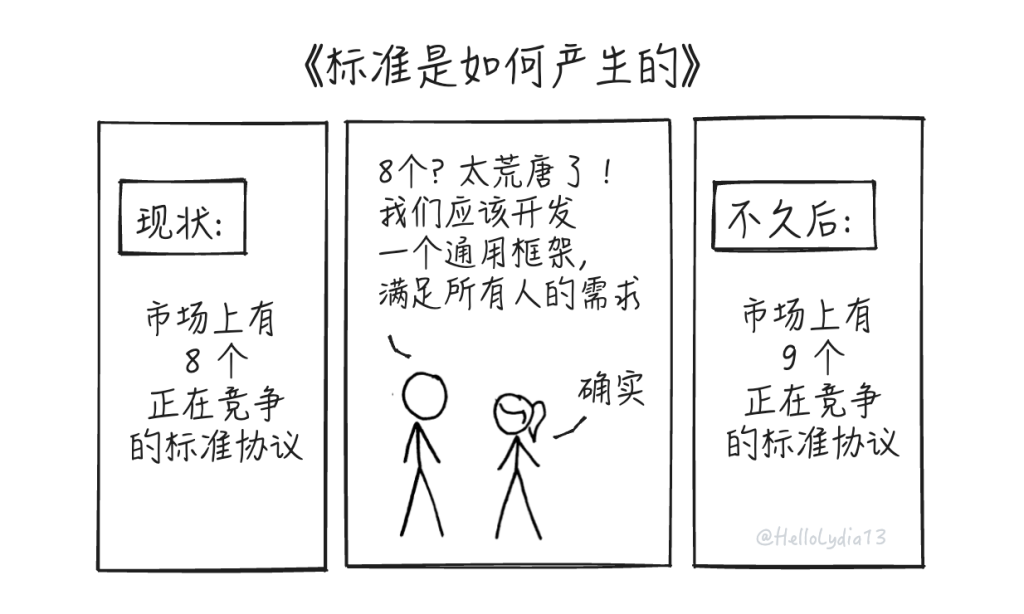
If you were confused when first encountering the concept of "chain abstraction," you are not alone.
—It seems important, with many projects and a lot of funding, all claiming to be the standard… but not knowing what it's for. Is "chain abstraction" just another buzzword on the Web3 concept pipeline?
This article will start from the concept, return to the basic questions, and hopefully scoop out pearls in the sea of nothingness.
TL; DR
The purpose of abstraction is to hide complexity, and the level of abstraction in the Web3 context is often higher than in Web2 (hence more difficult)
Modularization reduces the threshold for building public chains, while chain abstraction includes the reorganization of public chain relationships and improvements in user/developer experience
Cross-chain asset transfer, cross-chain communication, interoperability, and distinguishing chain abstraction: a subset of concepts centered around coordinating state changes (transactions) on different chains (but often filled with gray areas in practical use)
Intent-based chain abstraction solutions have become a popular architecture, and many component-like products may gradually form the final form of chain abstraction
The industry's current discussion and construction of chain abstraction have not yet broken the superstition of infra-centricity, and the establishment of chain abstraction as a real problem depends on the activity on the chain, modularization progress, and the entry of new users and developers
The future of chain abstraction is not a smooth path, and it needs to consider the impact on long-tail public chains and explore applications other than DeFi
What is the problem with chain abstraction?
Is chain abstraction a real problem?
If so, what category does it belong to among the many problems?
What are the differences between cross-chain, interoperability, and chain abstraction?
Is chain abstraction a real problem?
—Not necessarily. The establishment of a problem requires context. Imagine asking someone 500 years ago about their views on the energy crisis.
So where does our discussion of chain abstraction come from?
Different answers may include several key words: Ethereum's roadmap, modularization, intent, mass adoption… The most explanatory view at present may be that chain abstraction is the second half of modularization.
To understand this view, it is necessary to explain the definition of chain abstraction.
In computer science, "abstraction" refers to the process of separating high-level operations and concepts from background processes, with the aim of simplifying understanding by hiding complexity. For example, most Web2 users only need to know about browsers and ChatGPT, and may not even need to know the abstracted content or concepts themselves.
Similarly:
Account abstraction: By hiding internal information such as the address, private key, and mnemonic of a blockchain account, the account can be used without awareness
Chain abstraction: By hiding internal information such as the consensus mechanism, gas fees, native tokens of each chain, the chain can be used without awareness
In traditional software development, abstraction and modularization are closely related important concepts. Abstraction defines the hierarchy and architecture of the system, while modularization is the way to implement this architecture. Specifically, each module represents an abstraction level, and the interaction between modules hides their internal complexity, facilitating code extension, reuse, and maintenance. Without abstraction, the boundaries between modules would become complex and difficult to manage.
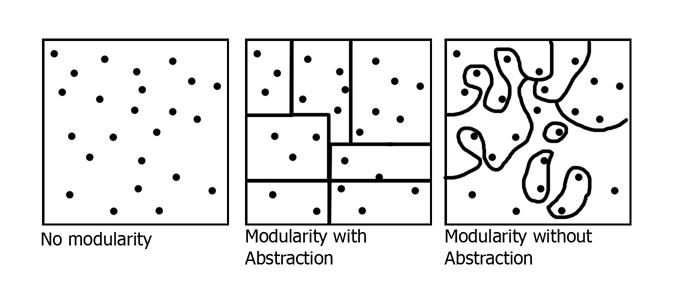
Source: https://web.cs.ucla.edu/classes/winter12/cs111/scribe/3a/
It is worth noting that in Web2, abstraction and modularization usually occur within a closed or partially closed ecosystem, with abstraction levels concentrated within a single platform or application, and the environment relatively controlled, usually not needing to address cross-platform or cross-system compatibility issues. However, in the context of Web3, due to the pursuit of decentralization and an open ecosystem, the relationship between modularization and abstraction becomes more complex.
At present, although modularization helps solve the abstraction problem within individual public chains and reduces the threshold for building public chains, the abstraction of user/developer experience in a multi-chain landscape is an area that modularization has not fully covered. There are relatively obvious island effects between different public chains and ecosystems, specifically reflected in liquidity, developer, and user dispersion. The proposal of chain abstraction includes the reorganization of public chain relationships to achieve connection, integration, and compatibility between multiple chains, as confirmed in an article published by Near in January of this year.
We can consider that the urgency of chain abstraction as a real problem is closely related to the development of the following conditions:
On-chain activity: Whether more dApps bring more user on-chain activity
Progress of modularized blockchains: Whether more active on-chain behavior drives the construction of more rollups and app chains
Barriers to entry for new users and developers: To what extent the current blockchain environment hinders the influx of new users and developers (referring to the attrition in the rising trend, rather than the stagnation of migration)
What category does chain abstraction belong to among the many problems?
Chain abstraction itself is an abstract concept, and the narrative level within Web3 is relatively high-dimensional, which may explain why chain abstraction presents a diverse and even bewildering appearance. Specifically, it is not a solution, but a guiding ideology.
Another example is Bitcoin today, which, after experiencing several halvings, rapid rises and falls, and the landing of ETFs, has become not only a technical solution or asset category, but also a thought system and industry totem that transcends time, representing a series of core cryptographic values, and will continue to guide industry innovation and development in the visible future.
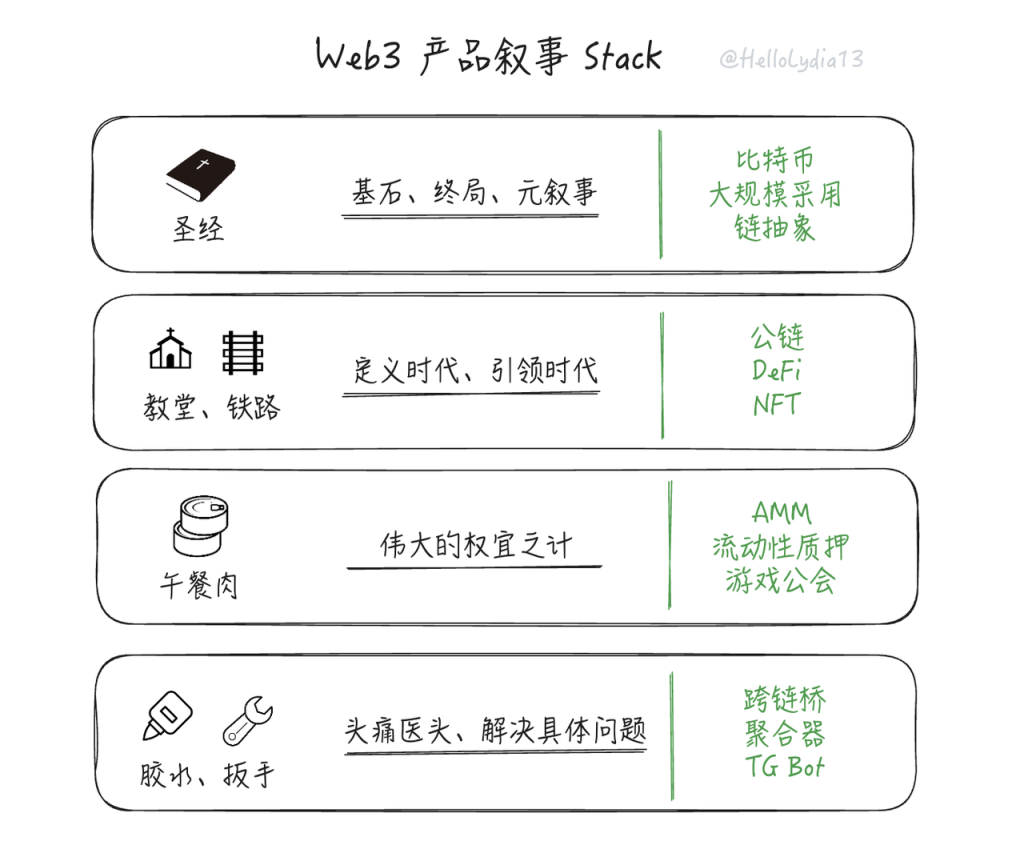
What are the differences and connections between cross-chain, interoperability, and chain abstraction?
We can also understand cross-chain, interoperability, and chain abstraction on a spectrum from specific to abstract. In terms of form, they are a subset of concepts centered around coordinating state changes (transactions) on different chains, but in practical use, they are often filled with gray areas.
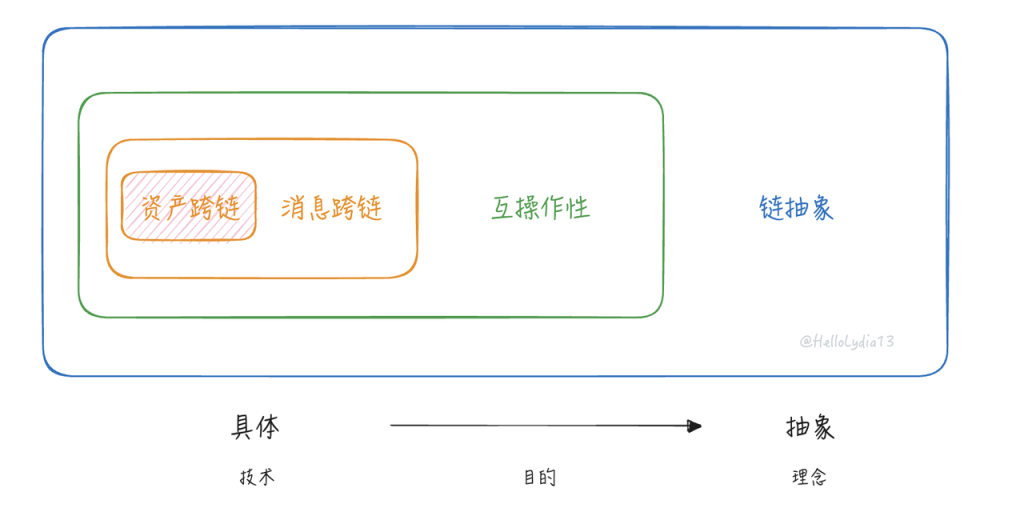
We can roughly divide cross-chain related applications and protocols into two categories:
Cross-chain asset transfer: Cross-chain bridges, cross-chain AMMs, cross-chain aggregators, etc.
Cross-chain communication: Layerzero, Wormhole, Cosmos IBC, etc.
The transfer of assets also involves message passing. The message passing layer of cross-chain asset transfer applications generally consists of a set of on-chain smart contracts and state update logic. Abstracting this message passing functionality into a general, protocol-level solution is a cross-chain communication protocol.
Cross-chain communication protocols can handle more complex cross-chain operations, such as governance, liquidity mining, NFT trading, token issuance, game operations, etc. Interoperability protocols go further, involving deeper data processing, consensus, and verification, ensuring consistency and compatibility between different blockchains at the blockchain system level. However, in practical use, these two concepts often complement each other and can be used interchangeably depending on the context.
The connotation of chain abstraction includes interoperability of blockchains, but the usage context adds a layer of improvement in user and developer experience, which is not unrelated to the rise of the intent narrative in this period. The combination of intent and chain abstraction will be elaborated in the following section.
What specific problems does chain abstraction include?
How to implement chain abstraction?
Why should we pay attention to the combination of chain abstraction and intent?
How to implement chain abstraction?
Different projects have different understandings and entry points for chain abstraction. Here, we divide it into the classical school, which evolves from interoperability protocols and focuses more on developer-side abstraction, and the intent school, which combines emerging intent architectures and focuses more on user-side abstraction.
The classical school's history can be traced back to Cosmos and Polkadot, which were born long before the concept of chain abstraction. OP superchain and Polygon Agglayer, as newcomers, currently focus on liquidity aggregation and interoperability within the Ethereum L2 ecosystem. Cross-chain communication protocol-based Layerzero, Wormhole, and Axelar are also expanding to more chains, striving for more customer adoption to enhance their network effects.
The intent school includes L1s such as Near and Particle Network, which are dedicated to providing comprehensive solutions for chain abstraction, as well as component-based solutions that start from solving specific problems, currently dominated by DeFi protocols, represented by UniswapX, 1inch, and Across Protocol.
Whether in the classical or intent school, secure and fast cross-chain operations and friendly interactions are at the core of the design, including but not limited to a unified user interface, seamless cross-chain dApp usage, gas sponsorship, and management.
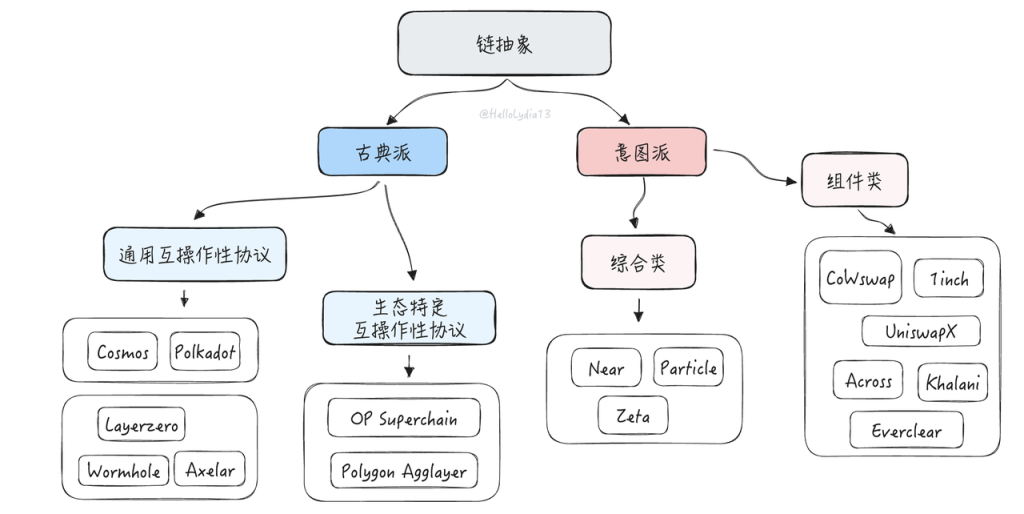
Why should we pay attention to the combination of chain abstraction and intent?
The emergence of "intent-based xx protocols" is endless. This section will explore the reasons and potential of its popularity as a product architecture.
Similar to abstraction and modularization, intent is not a native concept of Web3. Intent recognition has existed in the field of natural language processing for decades and has been extensively researched in human-computer dialogue.
When it comes to intent research in the Web3 field, it is inseparable from Paradigm's famous paper. Although similar design concepts have been reflected in products such as CoWSwap, 1inch, and Telegram Bot, the core of the intent architecture was formally proposed in this paper—users only need to specify the desired result without caring about the process, and the complex process of task execution is best outsourced to a third party. This aligns with the focus of chain abstraction on improving user experience and provides a more concrete solution approach.
There are many well-known architectural classifications of chain abstraction in the market, with the CAKE framework (Chain Abstraction Key Elements) developed by Frontier Research being one of them. This framework combines intent architecture and categorizes various technologies and solutions that constitute chain abstraction into permission layer, solver layer, and settlement layer. Other frameworks have made adjustments based on this, such as Everclear, which adds a clearing function between the solver layer and the settlement layer.
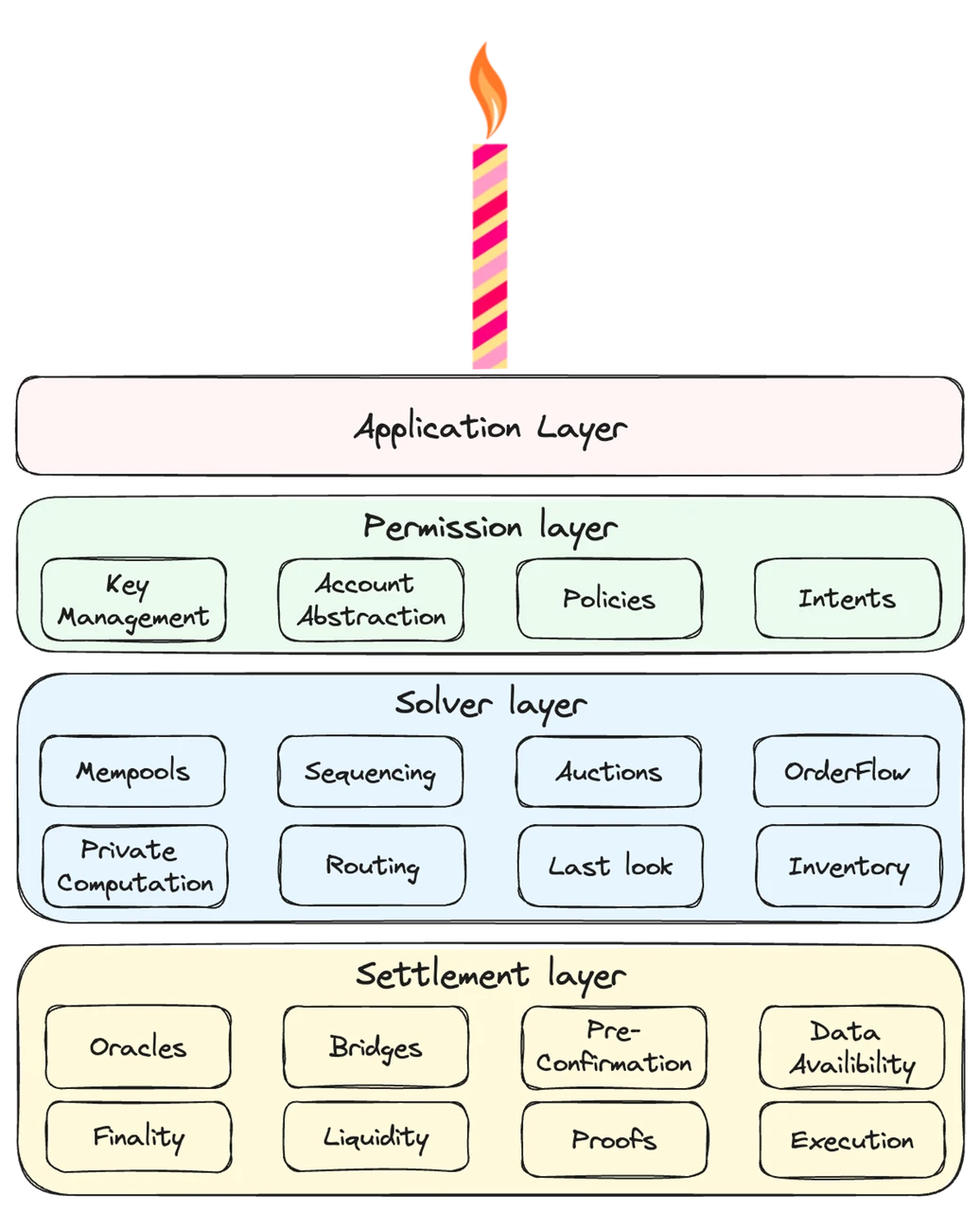
Source: Frontier Research
Specifically:
Permission Layer: The core is account abstraction, serving as the user entry point for dApps to request intent quotes—users express intent
Solver Layer: Generally a third-party solver layer off-chain, used to fulfill user intent—solvers compete for orders
Settlement Layer: After the user approves the transaction, it calls oracles, cross-chain bridges, and other solutions to ensure transaction execution—users obtain the expected results, solvers receive rewards
Solvers in the solver layer are a group of third-party off-chain entities, referred to as solvers, resolvers, searchers, fillers, takers, relayers, etc., in different protocols. Solvers usually need to stake assets as collateral to qualify for competing orders.
The process of using intent products by users is similar to placing a limit order. In a cross-chain scenario, to quickly fulfill user intent, solvers often advance funds and charge a certain risk fee at settlement (this model is similar to a short-term loan, with the loan term = blockchain state synchronization time, and interest = service fee).
Comprehensive intent solutions represented by Near hope to combine the permission layer, solver layer, and settlement layer into a unified infrastructure product, currently in the early stage of concept verification, making it difficult to directly observe and evaluate its utility.
Component-based intent solutions represented by cross-chain DeFi protocols have shown more obvious advantages compared to traditional cross-chain modes (such as Lock & Mint, Burn & Mint). As the flagship product of Across Protocol, Across Bridge, based on intent architecture, gives it first-tier speed, low cost, and fee capabilities in the EVM ecosystem's cross-chain bridge, particularly evident in small-scale cross-chain scenarios.

Aggregator displaying the cross-chain speed and fees of different products
Source: Jumper
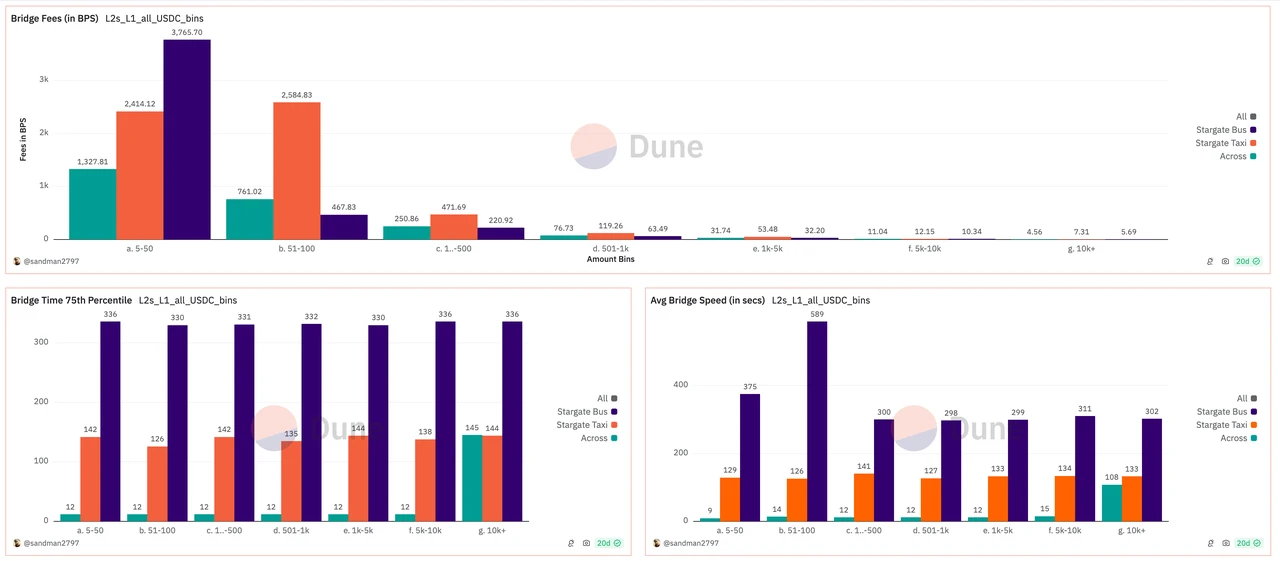
Comparison of speed and fees between Across Protocol and Stargate in L2-L1 scenarios
Source: https://dune.com/sandman2797/across-vs-stargate-taxi-vs-bus-eth

Fee capabilities of Across Protocol
Source: DefiLlama
Looking at the roadmap, Across Protocol will launch the cross-chain intent settlement layer in the third phase. The ERC-7683 proposed by Uniswap Labs and Across Protocol attempts to lower the entry barrier for solvers through standardized intent expression and build a general network for solvers. Many component-based products may gradually form the final form of chain abstraction as a puzzle.
What problems do we have in understanding and practicing chain abstraction?
What problems does infra-centricity bring?
What other issues are worth considering regarding chain abstraction?
What problems does infra-centricity bring?
As the leader of interoperability protocols, Layerzero has raised a total of 290 million, while Wormhole has raised 225 million. Their high valuations and low circulation make their tokens representative of the heavily criticized VC coins in this period, undermining market confidence in the chain abstraction track.
Returning to the cartoon at the beginning of the article, chain abstraction projects each have a technical stack and token standards. In the absence of external incremental market environment, they are inevitably criticized as "air infrastructure." The significant data discrepancy before and after the Layerzero airdrop has also led to market doubts about the real demand for "cross-chain communication."

Significant data discrepancy before and after the Layerzero airdrop
Source: https://dune.com/cryptoded/layerzero
On the ERC-7683 forum page, in response to doubts about the cross-chain asset transfer function being too small, not universal enough, and not supporting enough ecosystems, developers have discussed the responsibilities of the ERC standard itself. Supporters of the minimalist ERC believe that tool-level standards are sufficient to solve current problems and can be combined with existing standards with relatively little resistance.
Considering that the design philosophy of intent architecture is largely aimed at applications, "universal, full-stack, and compatible" protocol standards can sometimes become "too general and meaningless" or "too large and difficult to solve practical problems," leading to a somewhat ironic phenomenon—chain abstraction protocols, born to solve fragmentation problems, themselves offer fragmented solutions.

Source: https://ethereum-magicians.org/t/erc-7683-cross-chain-intents-standard/19619/18
What other issues are worth considering regarding chain abstraction?
For new public chains/long-tail public chains, chain abstraction increases the difficulty of retaining TVL (analogous to the impact of globalization on underdeveloped areas). What kind of impact will this have on the adoption of chain abstraction?
A study by Variant points out that UniswapX will lead to a situation where long-tail tokens are directed towards AMM, and mainstream tokens are filled by off-chain solvers. Is this the future trend of DEX? Will there be a global solver layer added on top of the future global liquidity layer?
Apart from DeFi protocols, what other forms might be the product architecture based on intent?
Will chain abstraction become a hot trend or a big bubble after modularization?
免责声明:本文章仅代表作者个人观点,不代表本平台的立场和观点。本文章仅供信息分享,不构成对任何人的任何投资建议。用户与作者之间的任何争议,与本平台无关。如网页中刊载的文章或图片涉及侵权,请提供相关的权利证明和身份证明发送邮件到support@aicoin.com,本平台相关工作人员将会进行核查。




